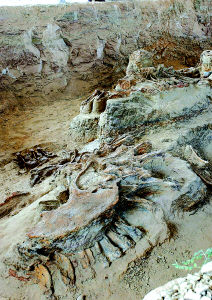
Ma Yun, a Muslim farmer from northwest China's Ningxia Hui Autonomous Region, has discovered
a dinosaur fossil that has been dubbed a "national treasure". The
excavation was televised 'live' by China Central Television (CCTV)
on Saturday afternoon.
Ma was hunting hedgehogs on a hill in Lingwu City in April 2004,
when he chanced upon a "brown stone" about 20 cm in diameter. He
thought the stone resembled an enormous "limb of some animal", but
none of his friends he dragged to the spot was convinced. It was
only five months later when he contacted the Lingwu Bureau of
Cultural Relics that his suspicions were confirmed; the "stone" was
identified as a dinosaur fossil.
"I guessed that it was," said the contented farmer, who was so
excited to appear on TV that he had his long hair cut.
It was the first time that a dinosaur fossil excavation was
shown 'live' in China. The program documented excavation projects
in Lingwu City, and in Changji Hui Autonomous Prefecture of
northwest China's Xinjiang Uygur Autonomous Region a few hundred
kilometers away here Asia's largest Mamenchisaurus was
unearthed.
"We decided to do this live broadcast because the fossils are so
precious," said Xu Xing, an archaeologist and researcher with the
Institute of Vertebrate Paleontology and Paleoanthropology of the
Chinese Academy of Sciences (CAS), who was invited as a guest
expert by CCTV.
Eight sauropods, or huge, long-necked herbivorous dinosaurs that
lived in the middle Jurassic period some 160 million years ago,
were unearthed within a 3,000-square meter area in Lingwu, Prof Xu
said.
28 teeth were laid out in order on the ground. Xu noted that it
was likely a skull was still buried.
Experts have also found a 1.1-meter-tall backbone, the biggest
ever excavated in Asia.
Prof Xu, who has named 15 new dinosaur species to date, believes
that the dinosaur is a sub-species of the diplodocus, mainly found
in the southern hemisphere in places like Tanzania and Argentina.
Other diplodocus fossils have been found in North America.
Discovery of the species in Asia could support the Continental
Drift Theory, which states the African, American and Asian
continents used to be connected, Xu said.
The fossils could also help experts make out geological changes
that have taken place in northwest China, as Xu noticed some bones
had been washed away in this arid area. He believed that the spot
might have been a river delta of sorts millions of years ago.
The sauropod used to be the biggest dinosaur on land during the
Jurassic period. They could grow up to 40 meters long and weigh
over 100 tons.
Experts believe that more fossils could be excavated in the
area.
Questions have also been raised over the mammoth's
disappearance. "It is rare to find so many dinosaurs, with varying
sizes, buried together," said Mo Jinyou, professor with the Guangxi
Natural Museum who helped with the excavation in Lingwu. Mo guessed
that death of the dinosaurs could be caused by some "unnatural
reasons".
The fossils will be preserved on the spot, where a museum is to
be built, according to Wang Jun, vice director with the Publicity
Department of Lingwu.
Meanwhile, a national geological park featuring wood and
dinosaur fossils opened in Changji in Xinjiang on Saturday, where
the largest dinosaur in Asia was unearthed.
The dinosaur, 35 meters in length, is five meters longer than
the current "No. 1 dinosaur in Asia", which was discovered by a
Sino-Canadian archaeological team in 1987 and is on display at the
Natural Museum in Beijing.
In 1902, China dug out its first dinosaur fossil in northeastern
Heilongjiang Province. In 1979, a cluster of dinosaur fossils was
found in southwestern Sichuan Province's Zigong City, where a
dinosaur museum now stands. The museum houses the complete fossils
of more than 100 dinosaurs.
At present, the number of dinosaur fossils unearthed in China is
the third largest in the world. They have been classified into over
100 categories.
Experts are asking the public to suggest names for the
dinosaurs. Many have suggested that the fossil in Lingwu be named
after Ma Yun.
Meanwhile, Ma has named his son "Xiao Long", which is the name
of a type of dinosaur. "It is the tallest dinosaur," he said.
(Xinhua News Agency August 28, 2006)

